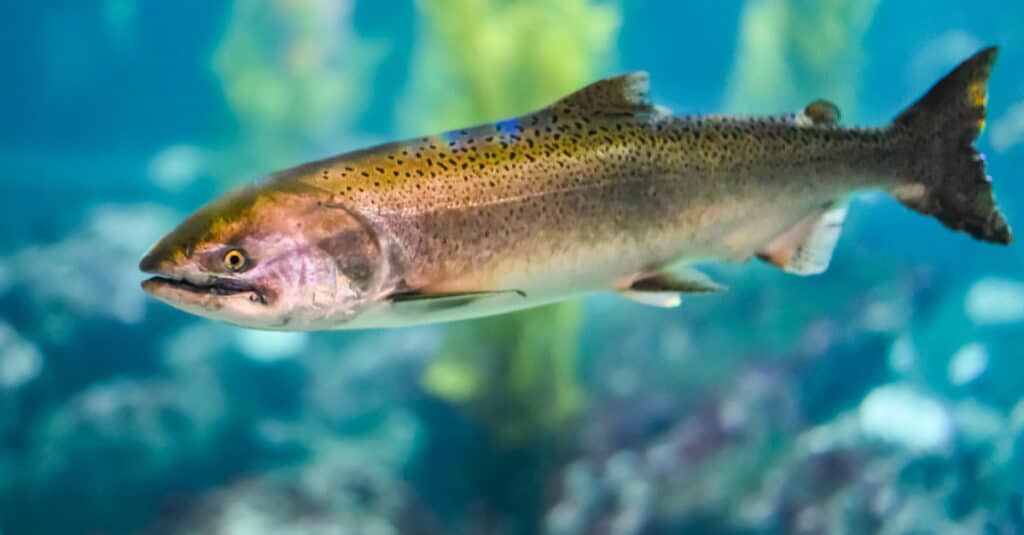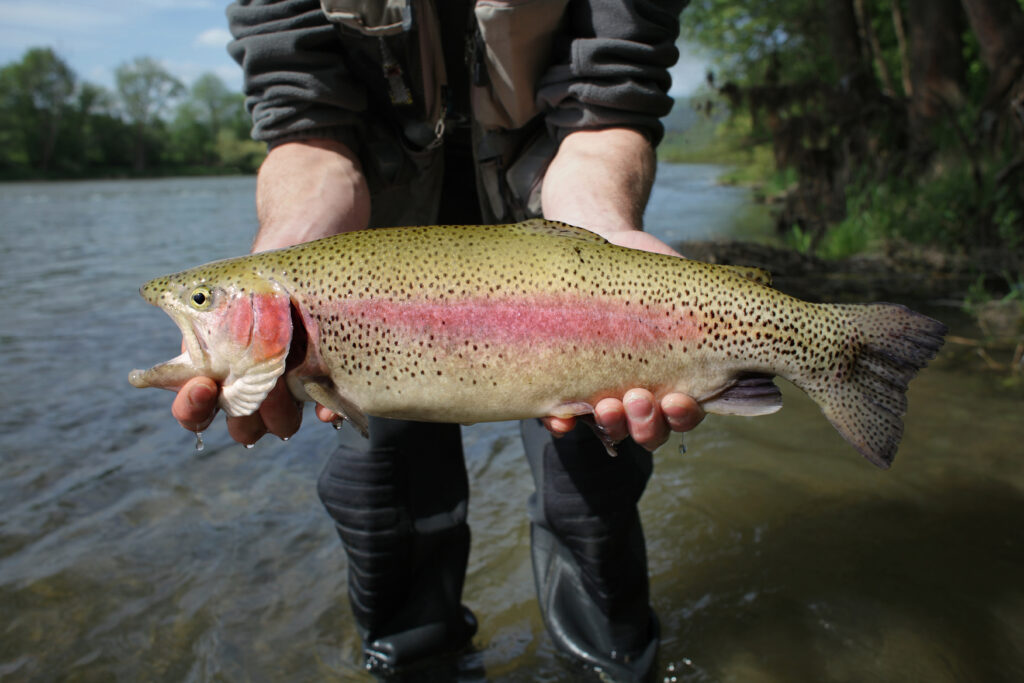There are some physical differences but those come about because of differences in behavior. They’re the same species, yet one is anadromous, which fundamentally changes them. Learn how to tell the difference between steelhead and rainbow trout!
Physical Differences Between Steelhead and Rainbow Trout
There are a couple of notable physical differences between these two types of fish. Steelhead trout are typically more of a silver color and grow larger than rainbow trout. Since they navigate the ocean, they develop a more streamlined shape. Rainbow trout, on the other hand, are usually the smaller fish of the two, and their color is, instead of remaining solely silvery, more vibrant. You can see distinctive reds and pinks along the sides of their bodies.

Rainbow trout are excellent swimmers, able to swim against the current and make their way upstream.
©Henrik A. Jonsson/Shutterstock.com
Lifecycle and Behavior of Steelhead and Rainbow Trout
Both types of trout are native to North America, and both start out in the same freshwater environments. They may either live in lakes or streams, using wood and aquatic vegetation as shelter. The difference between the two is that steelhead depart from their freshwater environments to swim out into the ocean. They return to freshwater only when it’s time to spawn.

Steelhead trout are the anadromous variety of rainbow trout and are more silvery in color.
©David A Litman/Shutterstock.com
When they spawn, the females head straight to the bottom of streams to create a slight depression. This is a suitable spot for her to deposit her eggs. The males then find the eggs and fertilize them. Since they are in the gravel part of the stream’s bottom, the eggs are protected and remain there until it’s time for them to hatch. Steelhead, unlike other types of fish, can spawn several times throughout their lives. They can head back out to the ocean and return to freshwater environments to spawn again and again.
Fishing Techniques and Regulations for Catching Steelhead and Rainbow Trout
Rainbow trout are known for their strength. They’re excellent swimmers, able to swim against the current and make their way upstream. It’s a favorite for anglers and a great challenge for those just starting out. This is an anytime fish in the mid-Atlantic region, but anglers should always review stocking schedules for their states.
There are regulations when fishing for rainbow trout that specify seasons and size limits. However, each state has its own regulations that require review depending on your location. So long as you’re fishing in freshwater, you can find rainbow trout in ponds, lakes, rivers, and streams.
How you fish for rainbow trout is ultimately up to you but some tried and true bait for rainbow trout include worms, salmon eggs, live nymphs and minnows, and colorful marshmallows if you’re going for hatchery fish. When it comes to lures, crank baits that imitate minnows are great for fall and weighted spinners are good to use in the spring. Just make sure they have flat blades.

Rainbow trout are a highly sought after type of fish for anglers throughout North America.
©pictoplay/Shutterstock.com
To fish for steelhead, focus on the west coast from Alaska down to California. These fish are known for the incredible fights they put up. They’re not the easiest to catch. They can be found along the coast, but they also travel inland, sometimes as far as Idaho. You have to know which waters to target when you plan on fishing for steelhead. There are steelhead runs in the summer and in the winter. These fish like rocky environments in a depth of at least a few feet.
They like the cover, so these habitats are more likely to hold the fish you’re looking for. If you notice large rocks, bounce your bait or lure and navigate it so that it sinks into the little pockets behind those larger rocks. Another great location for finding steelhead is the areas where the water slows. They may be resting there before heading back out to the river rapids.
Nutritional and Culinary Differences Between Steelhead and Rainbow Trout
You already know there is a notable size difference between steelhead and rainbow trout. But steelhead trout are also higher in vitamin B12. By 62 %! Rainbow trout, on the other hand, has higher levels of vitamin A and vitamin D. Steelhead, unsurprisingly, has higher levels of sodium. It has more iron, potassium, selenium, phosphorus, zinc, calcium, and magnesium.
Along with vitamin A and vitamin D, rainbow trout also contains more vitamin C and vitamin K. Both types of fish are equal in vitamin E. They contain similar amounts of protein and steelhead contains a little bit more fat. Preparation depends on preference, but both are delicious when baked with garlic and butter.
The photo featured at the top of this post is ©
Thank you for reading! Have some feedback for us? Contact the AZ Animals editorial team.







